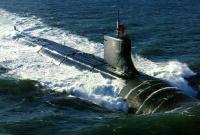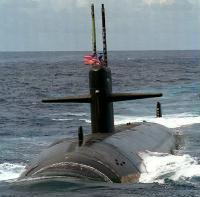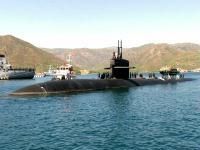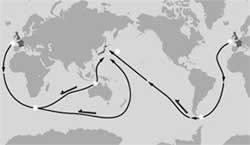Nuclear submarine risk
2000/11/14 Urresti, Igor - Elhuyar Zientziaren Komunikazioa

In recent months, after the breakdown of the HMS Tireless submarine in Gibraltar and the sinking of the Kursaal, nuclear submarines are on everyone's lips. These submarines normally carry nuclear weapons, but it is not the reason for their registration as a nuclear submarine. It is named after the type of propulsion they use, since they use nuclear reactors.
The initial submarines used Diesel engines. The diesel engines had no problem moving through the surface of the water, but when they needed oxygen for combustion, they could not continue to function under water. These submarines are provided with at least two Diesel engines, and when they are on the surface, while one is propelling the submarine, the other can charge electric batteries. The batteries are the ones that give strength to the submarine when it is under water. However, they do not have too much autonomy and, therefore, the submarines must often return the surface.

For this reason, since the 1960s, it is customary for submarines to use nuclear force. Nuclear reactors do not need oxygen and the submarine can stay for a long time under water. In addition, since nuclear fuel lasts longer than diesel, they do not have to return to port frequently. These submarines have enough autonomy to make 40 turns around the world and the limit of being underwater is the crew's ability to withstand solitude.
The nuclear reactors of these submarines are the same as the reactors existing in conventional nuclear power plants. The heat of the reactor heats the water to pressure. The heat of this first circuit produces a steam that heats the second independent water circuit and moves the steam turbine. In this way, when it works properly, it is not possible to remove radioactivity outside. Finally, turbines can directly affect the propellers or generators of electricity. Since the nuclear reactor carried by the submarines is less than that of the power plants, the radioactive fuel is richer.
Accidents and accidents Accidents Accidents

In the case of Tireless, there was a radioactive water leak from the first circuit. At the height of the island of Malta they realized the fault and until arriving to Gibraltar they were deliberately released 200 liters of radioactive water. In addition, the Guardian newspaper has published that the main reactor was prepared to make a serious mistake. The British Ministry of Defense has acknowledged that seven of its twelve submarines need immediate repairs.
In the case of the Kursaal, fortunately it seems certain that it did not carry nuclear weapons, and according to the Russians, the two submarine nuclear reactors have not suffered malfunctions. It seems that the reactors started a process of automatic disconnection nothing more to produce the accident. But unfortunately the motives of our concern do not end there. After the emergency stop of the ship Kursaal, it is necessary to cool the reactor. There is no risk of explosion during the proper operation of the cooling system or mass release of radioactivity to the sea. This has prevented the initial nuclear discharge. But it seems that the Russians do not intend to emerge the Kursaal and it is possible that over time there will be a radioactive leak. This is possible in the near future, especially when the underwater structure itself is quite damaged. In addition, it is sunk in the fish streets of the Barents Sea and its influence on the surrounding ecosystems is yet to be clarified.

Gai honi buruzko eduki gehiago
Elhuyarrek garatutako teknologia






